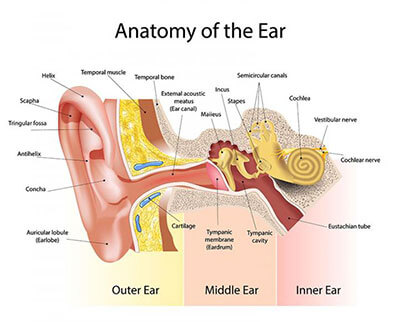

It is, no doubt, frustrating to not hear well enough to enjoy activities and engage in conversations. If you are experiencing hearing loss, you are not alone. The NIH National Institute on Deafness and Other Communication Disorders states that approximately 15 percent of American adults (37.5 million) aged 18 and older report some trouble hearing.
Hearing loss may be caused by genetic factors, the aging process, exposure to loud noises, certain medications, infections, head or ear trauma, congenital (birth or prenatal) or hereditary factors, diseases, as well as a number of other causes.
Hearing loss isn’t the same in every person. It can occur in one or both ears. Different parts of the ear can be impacted. It varies in type and severity. While hearing can never be restored to “normal,” there are treatment options depending on the type of hearing loss you may have.

To understand the different types, it helps to understand how the ear is structured. The structures of the ear are separated into three sections: the outer ear, middle ear and inner ear. The outer ear includes the part of the ear you can see as well as the ear canal. The middle ear starts at the eardrum and extends through the three middle ear bones. The inner ear begins with the cochlea, which houses the hearing organs and is embedded in the skull. Hearing occurs when the auditory nerve sends auditory signals received from the cochlea into the auditory cortex of the brain. If any part of this pathway is damaged, it can have an effect on our ability to hear sound.
Rarely, a sudden sensorineural hearing loss can take place. This is when a person notices a severe decrease in their hearing, in one or both ears, in an instant. These losses can sometimes be treated. Success with medical treatment for sudden sensorineural hearing loss is related to how quickly it can be treated. Typically, some return of hearing is most likely when the person is treated within 24 to72 hours. For this reason, sudden hearing losses are treated as medical emergencies and should be followed up with an audiologist and an ear nose and throat specialist, as soon as possible after onset.
Conductive hearing loss can also be caused if someone has a deformed or missing outer ear (microtia) or has no ear canal (atresia). Typically, malformations of the outer ear are congenital (present at birth) but can also be acquired through trauma of the ears. Recommendations for these losses can vary case-by-case, and can include treatment such as medication or surgery, or hearing devices such as traditional hearing aids and bone anchored hearing aids. Treatment is often recommended by an ear, nose and throat physician.
Of course, if you feel that you are experiencing hearing loss, you should not wait to see an audiologist. If you have any of the symptoms below, you should schedule a hearing evaluation.
Hearing loss may be caused by genetic factors, the aging process, exposure to loud noises, certain medications, infections, head or ear trauma, congenital (birth or prenatal) or hereditary factors, diseases, as well as a number of other causes.
Hearing loss isn’t the same in every person. It can occur in one or both ears. Different parts of the ear can be impacted. It varies in type and severity. While hearing can never be restored to “normal,” there are treatment options depending on the type of hearing loss you may have.

Types of hearing loss
Hearing loss can be categorized into three different types, each type explaining what anatomical structures are responsible for the hearing loss.To understand the different types, it helps to understand how the ear is structured. The structures of the ear are separated into three sections: the outer ear, middle ear and inner ear. The outer ear includes the part of the ear you can see as well as the ear canal. The middle ear starts at the eardrum and extends through the three middle ear bones. The inner ear begins with the cochlea, which houses the hearing organs and is embedded in the skull. Hearing occurs when the auditory nerve sends auditory signals received from the cochlea into the auditory cortex of the brain. If any part of this pathway is damaged, it can have an effect on our ability to hear sound.
Sensorineural hearing loss
The most common type of hearing loss, sensorineural hearing loss, is caused by damage of the inner ear nerves (hair cells) in the cochlea. Aging and exposure to loud noise are the most common causes of hair cell damage. This type of hearing loss can also be caused by growths (benign or malignant) along the auditory nerve leading up to the brain. Sensorineural hearing loss cannot be reversed, as the structures of the inner ear are not repairable once damaged. This type of loss is generally treated with a traditional hearing aid. If the loss is too severe for a hearing aid, a surgically implantable device such as a cochlear implant or bone anchored hearing aid may be considered. If a person is not a candidate for a cochlear implant, or chooses to forego this treatment option, American Sign Language is most often utilized for the patient’s mode of communication.Rarely, a sudden sensorineural hearing loss can take place. This is when a person notices a severe decrease in their hearing, in one or both ears, in an instant. These losses can sometimes be treated. Success with medical treatment for sudden sensorineural hearing loss is related to how quickly it can be treated. Typically, some return of hearing is most likely when the person is treated within 24 to72 hours. For this reason, sudden hearing losses are treated as medical emergencies and should be followed up with an audiologist and an ear nose and throat specialist, as soon as possible after onset.
Conductive hearing loss
When a person has a healthy inner ear but sounds cannot get to the inner ear effectively it is called conductive hearing loss. This is most often due to an abnormal middle ear, but it can also be due to malformations of the outer ear. Middle ear issues that can cause a conductive hearing loss include eardrum perforations or abnormalities, ear infection, fluid, issues with the middle ear bones and growths in the middle ear space. Often these issues can be medically treated, however if medical treatment cannot be completed or is ineffective, the loss can be treated with hearing devices.Conductive hearing loss can also be caused if someone has a deformed or missing outer ear (microtia) or has no ear canal (atresia). Typically, malformations of the outer ear are congenital (present at birth) but can also be acquired through trauma of the ears. Recommendations for these losses can vary case-by-case, and can include treatment such as medication or surgery, or hearing devices such as traditional hearing aids and bone anchored hearing aids. Treatment is often recommended by an ear, nose and throat physician.
Mixed hearing loss
Mixed hearing loss is a combination of conductive and sensorineural hearing loss. It affects both the outer or middle ear, and the inner ear. In these cases, a portion of the hearing loss is generated by damage to inner ear structures, however the loss is further worsened due to a middle ear problem. If the middle ear problem can be medically treated, hearing will improve, but a person will still have a sensorineural hearing loss that may require a hearing aid, a bone anchored hearing aid or a cochlear implant.Hearing test recommendations
With so many potential causes for hearing loss, it is important to regularly have your hearing tested. Below are the recommendations for hearing tests.- Infants – screening completed at birth and/or formal testing if there is a failed screening
- Toddlers – yearly through age 5 who present risk factors or concerns with speech, language and/or hearing
- Ages 5 through 18 - screenings mandated by school district and/or concerns with hearing
- Ages 18 through 50 - every decade or with concerns
- Ages 50 and older – monitor every three years
Of course, if you feel that you are experiencing hearing loss, you should not wait to see an audiologist. If you have any of the symptoms below, you should schedule a hearing evaluation.
- Difficulty hearing people talk in noisy environments, such as a restaurant, shopping mall, in a car or on the television
- People seem to “mumble” all the time
- Family, friends or colleagues often have to repeat themselves when speaking with you
- You have trouble hearing people when they are not facing you or are in another room
- You have trouble following conversations
- You have ringing, buzzing or hissing sounds in your ears


.jpg?width=1280&height=720&ext=.jpg)